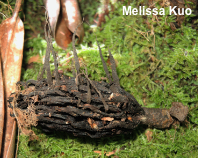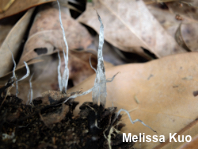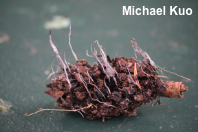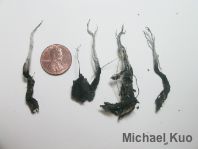| Major Groups > Clubs & Corals > Xylaria > Xylaria magnoliae |

|
Xylaria magnoliae [ Ascomycota > Sordariomycetes > Xylariales > Xylariaceae > Xylaria . . . ] by Michael Kuo The small, pointy species of Xylaria are not the easiest mushrooms in the world to identify, and they often require microscopic analysis—but Xylaria magnoliae is an exception, since it grows only on the decaying cones of magnolia trees (especially Fraser magnolia and southern magnolia). Aside from its habitat, Xylaria magnoliae can be recognized by its tough, narrow, blackish fruiting bodies that have a white interior, and its spores, which lack a germ slit and are unique among Xylaria spores in their pale brown, rather than dark brown, color. In spring and early summer the fruiting bodies are fairly smooth and feature a grayish to whitish dusting; this is the asexual stage of the fungus. By late summer, however, the surface becomes pimply and black as spores begin to develop and the fungus reaches maturity. Both stages are illustrated to the right. Xylaria jaliscoensis, known from the state of Jalisco in Mexico, also grows on magnolia cones but differs microscopically; its spores are smaller, dark brown, and feature a germ slit. Thanks to Sherwood Forest Friends for facilitating collection of specimens. Description: Ecology: Saprobic on decaying fruits of magnolia trees (especially Fraser magnolia and southern magnolia), growing gregariously, directly from the fruits; late spring through fall; southeastern United States. The illustrated and described collections are from Mississippi and North Carolina. Fruiting Body: 20–65 mm long; 0.5–3 mm thick; more or less cylindric, with a pointy apex; only occasionally branched; base black and fuzzy; surface at first gray to whitish and powdery, maturing to black, bald, and pimply; lacking a well-defined stem; interior flesh white and tough; perithecia in mature fruiting bodies more or less spherical, just below the surface. Odor: Not distinctive. Microscopic Features: Spores 13–15 x 3–4 µm; fusiform (reminiscent of bolete spores); smooth; pale brown in water; lacking a germ slit. Asci 8-spored. REFERENCES: J. D. Rogers, 1979. (Rogers, 1986; Metzler & Metzler, 1992; Rogers et al., 2002; Roody, 2003; Rogers, Miller & Vasilyeva, 2008; Woehrel & Light, 2017; Ju et al., 2018; Sturgeon, 2018.) Herb. Kuo 06061901, 08091906. This site contains no information about the edibility or toxicity of mushrooms. |
© MushroomExpert.Com |
|
Cite this page as: Kuo, M. (2019, October). Xylaria magnoliae. Retrieved from the MushroomExpert.Com Web site: http://www.mushroomexpert.com/xylaria_magnoliae.html |






